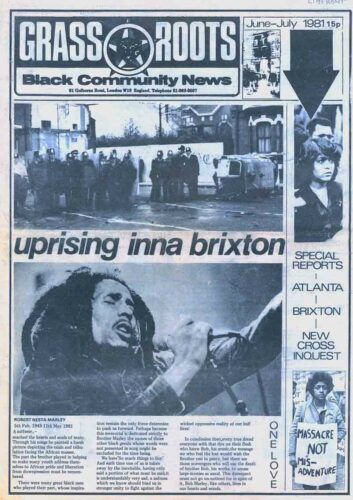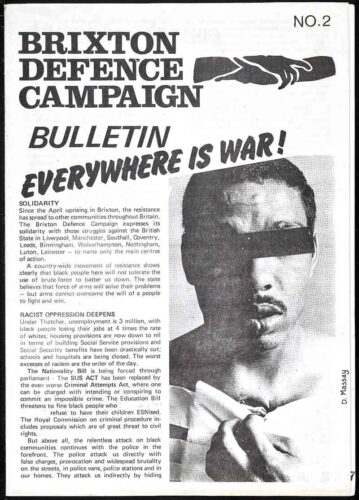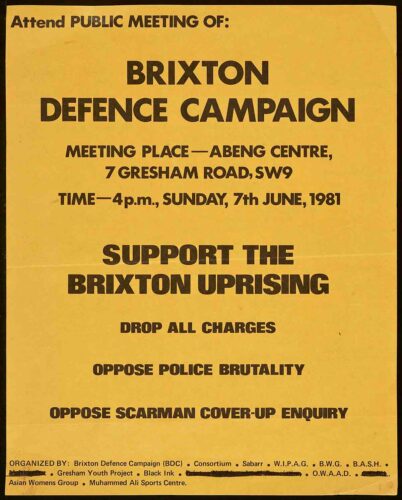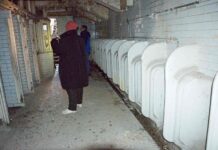Defend Yourself, an online exhibition by Brixton’s Black Cultural Archives, looks at the work of the Brixton Defence Campaign after the 1981 Brixton Uprising. Europe Singh, who was a member of the campaign, says it has many lessons for today

If you are expecting works of art displayed with some commentary you may be disappointed by this exhibition.
Produced and hosted by the Black Cultural Archives, Defend Yourself is a look back at the Brixton Uprising of April 1981 and its aftermath; in particular the work of the Brixton Defence Campaign (BDC) set up to provide those arrested with legal support and to continue the struggle against police harassment and the sus laws.
It is more a documentary piece about this period illustrated with leaflets and posters produced by the defence campaign.
So, although it is not a visually stimulating art exhibition, it is a highly informative and well presented look at this episode in the anti-racist struggle in the UK.

Solidarity
The exhibition highlights the fact that the BDC represented the solidarity amongst those struggling against racist attacks by right wing thugs and the police.
Not only was the campaign itself made up of “a variety of Brixton activist groups”, it also included other anti-racist organisations.
Although not fully articulated, there is a recognition that the term ‘black’ in 1981 encompassed all those people who were targets of racism – Asians and other minorities who faced attack.
The exhibition, for instance, includes a poster supporting the Bradford 12 – 12 young Asian men who had been arrested for conspiracy.
They had been involved in defending their community against violent attacks by racist thugs and were now victims of police attacks. They were eventually all acquitted.
The BDC offered them solidarity by publicising their struggle in Brixton and they emphasised this by publicly stating: “We must make the links between our experiences in Brixton and what is happening to the Black communities in courts elsewhere”.
The Scarman Report
The government asked the Law Lord Leslie Scarman to “inquire urgently into the serious disorder in Brixton … with the power to make recommendations”.
The exhibition explains that the BDC was against co-operation with Scarman because there was a concern that evidence given to the inquiry might further incriminate defendants and the inquiry was unwilling to grant immunity from prosecution to those giving evidence.
There were, however, a few black organisations that did give evidence despite this call for a boycott.
Embed from Getty ImagesThe legal defence
The BDC raised funds to support the defence of those arrested and charged and were ably supported by the Lambeth Law Centre.
I have to digress here to say that one of the leading lawyers from the law centre, who fought tirelessly to defend the youths in custody was Danny Phillips who recently died from Covid.

In addition to legal representation, the BDC organised for people to attend the court hearings to support defendants in the dock.
In the event, these efforts were not able to acquit all defendants, although the legal teams made a very clear case that during the “disturbances” the police were unable to make arrests and that individuals were arrested later and “trumped up” charges laid against them.
This finding did lead to many cases being thrown out and in other cases the legal teams successfully argued for reductions in sentences.
The BDC also found that the Met police grossly underrepresented the numbers stopped and searched in its Swamp 81 operation.
The police figure was 943, but the BDC found that 2,000 people were stopped and searched – 95% of whom were innocent of any charges.
The legacy
The BDC through its research “… underscored how race, racism and histories of colonialism and imperialism dictated the actions of courts, police, state institutions and press resulting in the criminalisation and imprisonment of black youths …”
Although the BDC disbanded in the mid-80s, the struggles against racism and police harassment continued.

Today we find ourselves once more in a situation where unemployment among Black youth is at catastrophic proportions, state sanctioned racism expressed in the Windrush scandal and the recent Sewell report continues, and police focus on Black youth is once again disproportionate and police powers are about to be strengthened by a new police bill.
Are we once again on the brink of fresh uprisings by Black communities?
The exhibition is not an exciting visual experience, but it is a clear account of an episode in Brixton’s history that gives us many lessons for the struggles we are fighting today.
The message is in our ongoing struggles “Unity is Strength”! Well worth visiting.
‘Defend Yourself, Unity is Strength’ The Brixton Defence Campaign (1981-1985)






